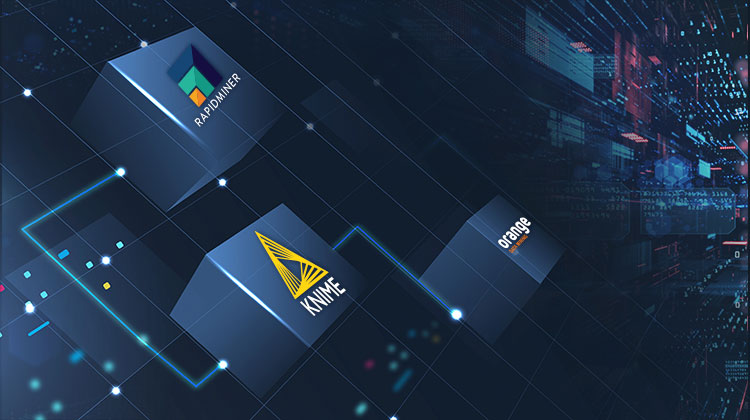Top 7 Data Mining Tools for 2024

Everyone agrees that data mining gives businesses enormous power to pull deep insights from massive amounts of data.
However, opinions differ when it comes to the data mining software to use.
Like operating systems, everyone involved in data engineering has their favorite data mining software. What works best for you depends on the size and quality of your dataset, the level of programming knowledge your users have, and your business goals.
We combed through reviews on G2, Capterra, and others to evaluate the most popular data mining tools going into 2024. This article includes our findings and insights from our data engineering professionals.
What is Data Mining?
Data mining is the process of uncovering hidden patterns and insights from large datasets. It uses a combination of statistics, machine learning, and database management techniques to extract valuable information that might be difficult or impossible to discover manually.
Data mining provides businesses with invaluable insights into their customers, the broader market, internal operations, and more. Companies in a wide range of industries leverage data mining software for data collection, analysis, modeling, interpretation, and visualization.
The knowledge gained from massive datasets would be time-consuming, inefficient, costly, and nearly impossible to find without the right software for data mining.
Data mining software reveals patterns and trends that users might have otherwise missed. It makes analyzing a variety of data types possible, including data from social media and customer service interactions.
Data mining programs can help manage the entire lifecycle of your data, from collection and cleaning to data modeling, visualization, and interpretation. They help you pull more detail and insight from your data than other data analytics tools.
Evaluating Data Mining Tools
As we said at the beginning, what makes the “best” data mining tool for you is subjective. You have to weigh several different factors when selecting a data mining tool for your business. The three most essential elements to consider are the tool’s compatibility with your data, the technical acumen needed to use it, and whether it can scale up as your data mining needs grow.
Compatibility with Your Data
Data mining software’s whole raison d’etre is to help pull valuable insights from your data sources. To do that, it needs to easily handle big data, structured and unstructured data, and data from any sources specific to your industry.
Modern data mining tools usually come with third-party integrations and connectors to the most popular data sources. It’s always good to verify it works with your existing infrastructure, though.
Technical Acumen
Data mining tools simplify complex analytics tasks, but that doesn’t mean they’re simple to use. While some functionality can be drag-and-drop, others might require knowledge of Python, SQL, and other programming skills.
When considering the technical know-how of the tools’ users, anticipate who else in your organization might eventually want or need to use the software. You may think only your data scientists will use it, but once others see what insights and reports can be generated, they may also want access. It’s hard to say no to the VP of Sales when they demand access for their team.
Features like low-code/no-code functionality, drag-and-drop configurability, automation, and customizable data visualizations may make your chosen data mining software more accessible to non-technical users.
Scalability
Data grows. So do demands for analysis of that data. No matter what size your company is now, plan for exponential growth in the amount of data you’ll need to collect, process, and analyze.
Your data mining tools need to scale with this growth. Scalable solutions support multiple algorithms and techniques and are highly configurable.
Your data mining software will also need to process high volumes of data rapidly. Data mining tools handle big data at speed in a few different ways, so check to see if it works with your current infrastructure.
Top Data Mining Tools
With that background in mind, here’s our list of the top software for data mining to consider this year.
1. RapidMiner
RapidMiner is a comprehensive data science platform that tackles several tasks in the data analysis pipeline, from data preparation and visualization to predictive modeling and deployment.
RapidMiner caters to users with varying skill levels. It offers a drag-and-drop interface for beginners to build data pipelines and models without coding. For advanced users familiar with data mining tools, Python scripting can be leveraged for greater customization and deeper analysis.
Key Features
- Unified, end-to-end data science platform
- Text mining and sentiment analysis
- Visual, drag-and-drop analytics workflows
- Low-code and code-based features
- Integrates easily with JupyterLab
2. KNIME Analytics Platform
KNIME is an open-source data science platform designed for data mining, analytics, and machine learning tasks. It boasts a modular workflow approach, letting users build data analysis pipelines by connecting individual nodes together like building blocks.
KNIME is ideal for individual data scientists, research teams, and organizations seeking a collaborative and accessible solution for data analysis, mining, and machine learning. While it might not be the strongest contender for highly specialized data science tasks, its flexibility, free availability, and community support make it a good choice.
Key Features
- Compatible with all file formats
- Task automation
- Workflow segment bundling
- Scripting integrations for Python, R, and JavaScript
- KNIME Community Hub repository
3. Orange
Orange is another open-source data mining tool for data visualization, machine learning, and data mining tasks. It offers a unique, visual programming front-end that allows users to build analysis workflows by connecting pre-defined “widgets” representing various data processing, modeling, and visualization functions.
Orange is powerful yet user-friendly. Its focus on visualization, extensive widget library, and ease of use make it a valuable option for individuals and organizations seeking an accessible and intuitive data mining solution. However, for highly specialized data science tasks requiring deep model customization, some commercial tools might offer more advanced functionalities.
Key Features
- Visual workflow design
- Extensive widget library
- Open-source and free
- Native support for most popular data formats
- Python-based solution
4. SAS Enterprise Miner
SAS Enterprise Miner is a feature-rich data mining tool developed by SAS, a leading provider of analytical software. It caters to established organizations and data scientists with large, complex data mining needs—and the budget to match.
SAS Enterprise Miner is a powerful and comprehensive data mining tool. Its advanced algorithms, statistical rigor, security features, and scalability make it ideal for in-depth research, risk management, and predictive modeling in various industries.
That said, its high cost and steep learning curve might pose limitations for smaller organizations or beginners.
Key Features
- Integrated analytical environment
- Industry-leading security and compliance
- Advanced data mining capabilities
- Highly scalable
- Tight integration with SAS Viya
5. Oracle Data Miner
Oracle Data Miner is an extension to Oracle SQL Developer offering a graphical interface for utilizing the data mining capabilities of Oracle Database. It allows data analysts and business users to explore their data, build and evaluate predictive models, and apply them to new data, all within the secure and familiar environment of their Oracle database.
Oracle Data Miner is a powerful and user-friendly option for organizations already using Oracle Database who want to explore data mining without significant additional investment. Its integration, ease of use, and comprehensive functionalities make it a valuable tool for data analysts and business users to uncover insights and gain predictive power from their data.
However, for highly specialized data science tasks or organizations not tied to the Oracle ecosystem, you might want to explore other data mining platforms.
Key Features:
- Compatible with Oracle Database, Spark, and Hadoop data sources
- Intuitive graphical interface
- Comprehensive data mining functionalities
- Wide range of data source types
- Model scoring and deployment
- Customization and automation features
6. Apache Mahout
Apache Mahout is an open-source library for scalable machine learning (ML) algorithms primarily focused on linear algebra. It runs on top of Hadoop MapReduce or Apache Spark, allowing it to handle large datasets efficiently.
Apache Mahout is a powerful and versatile tool for data scientists and developers who want to build and deploy scalable ML models on big data using distributed systems. Its rich math functionalities, diverse algorithms, and open-source nature make it an excellent fit for organizations exploring big data analytics and ML applications.
Downside: its steeper learning curve and code-centric approach might pose challenges for beginners or those seeking user-friendly data mining solutions.
Key Features
- Diverse ML algorithms
- Highly scalable
- Flexible and customizable
- Integrates with Hadoop components such as HDFS, HBase, and others
- Open-source software
- Community support resources
7. Teradata VantageCloud
Teradata VantageCloud is a comprehensive data analytics and data platform specifically designed for hybrid cloud environments. It combines the powerful data processing capabilities of Teradata Vantage with the scalability and elasticity of the cloud, providing organizations with a flexible and robust solution for managing and analyzing their data.
Teradata VantageCloud is a powerful and comprehensive data platform ideal for large enterprises with complex data needs and a hybrid cloud strategy. Its flexibility, advanced analytics capabilities, and security features make it valuable for organizations seeking to gain deeper insights from their data and leverage the power of AI/ML in a secure and compliant environment.
However, it’s another expensive solution. Its higher cost and complexity might put it out of reach of smaller businesses or those with less technical expertise.
Key Features
- Pre-built and customizable solutions
- Advanced analytics capabilities
- Meets strict data privacy and security regulations
- Integrated data platform
- Scalability and elasticity
Making the Call
This is a far-from-comprehensive list of data mining solutions. With the AI boom, more tools for mining data are hitting the market every few months. So how can you choose?
Some solutions eliminate themselves. For example, you can cross the expensive solutions off the list if you have a tight budget. Then, you can weigh the rest against your specific needs, your team’s technical expertise, and the size of your data.
After that, look for data mining programs with the functionalities you want, and you should end up with a more concise list.

